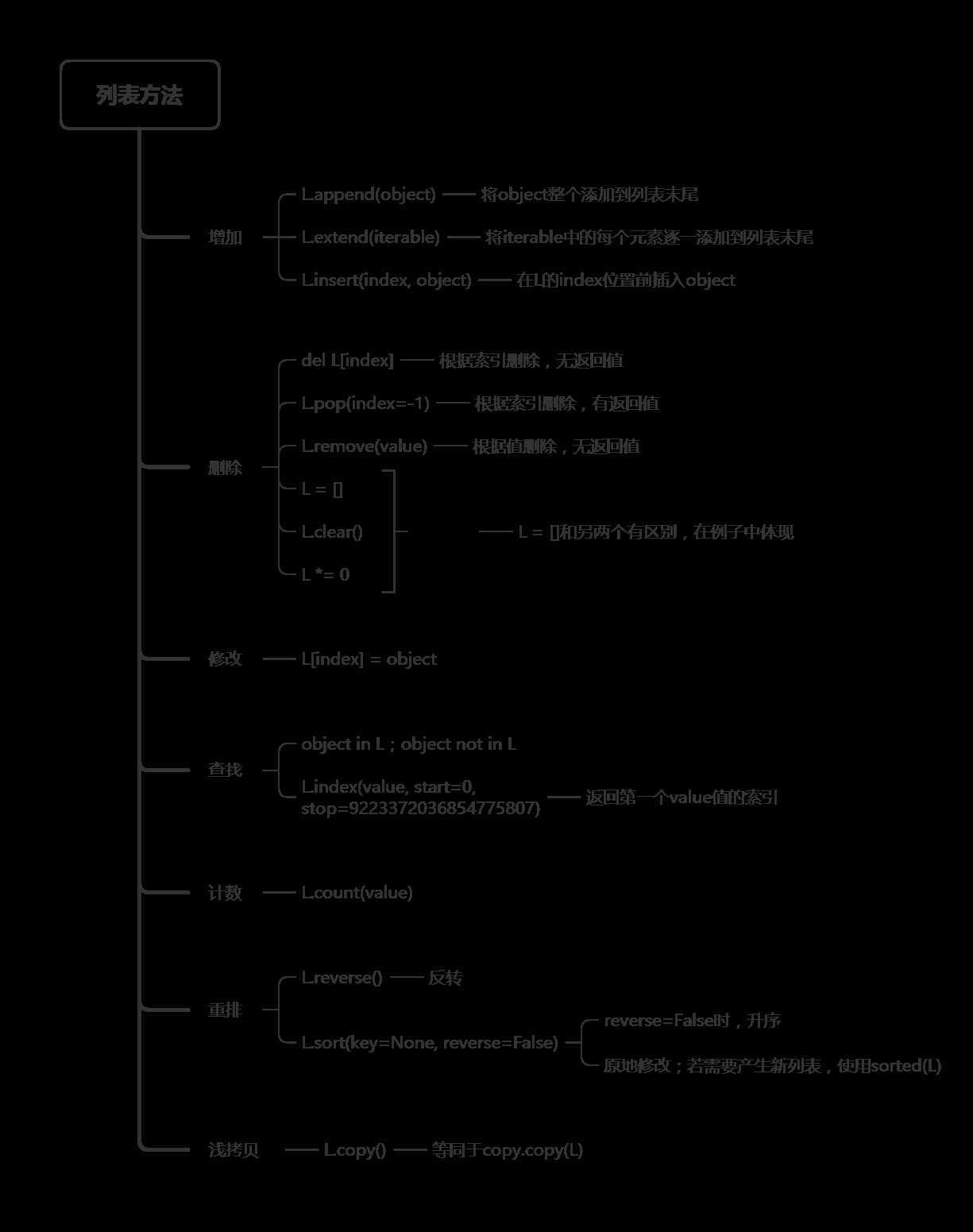1. 方法

2. 例子
(1)增加
1 >>> L = list(‘abc‘) 2 >>> L 3 [‘a‘, ‘b‘, ‘c‘] 4 >>> s = ‘def‘
1 >>> L.append(s) 2 >>> L 3 [‘a‘, ‘b‘, ‘c‘, ‘def‘]
1 >>> L.extend(s) 2 >>> L 3 [‘a‘, ‘b‘, ‘c‘, ‘d‘, ‘e‘, ‘f‘]
1 >>> L.insert(1, s) 2 >>> L 3 [‘a‘, ‘def‘, ‘b‘, ‘c‘]
(2)删除
1 >>> L = [‘a‘, ‘b‘, ‘c‘]
1 >>> del L[1] 2 >>> L 3 [‘a‘, ‘c‘]
1 >>> print(L.pop(1)) 2 b 3 >>> L 4 [‘a‘, ‘c‘]
1 >>> L.remove(‘b‘) 2 >>> L 3 [‘a‘, ‘c‘]
参考地址:https://www.cnblogs.com/BackingStar/p/10986775.html
1 >>> L = list(‘abc‘) 2 >>> first = [] 3 >>> last = [] 4 >>> for i in L: 5 first.append(i) 6 last.append(first) 7 first = [] 8 >>> last 9 [[‘a‘], [‘b‘], [‘c‘]]
1 >>> L = list(‘abc‘) 2 >>> first = [] 3 >>> last = [] 4 >>> for i in L: 5 first.append(i) 6 last.append(first) 7 first.clear() 8 >>> last 9 [[], [], []]
1 >>> L = list(‘abc‘) 2 >>> first = [] 3 >>> last = [] 4 >>> for i in L: 5 first.append(i) 6 last.append(first) 7 first *= 0 8 >>> last 9 [[], [], []]
(3)修改
1 >>> L= [‘a‘, ‘b‘, ‘c‘] 2 >>> L[1] = ‘z‘ 3 >>> L 4 [‘a‘, ‘z‘, ‘c‘]
(4)查找
1 >>> L = list(‘abcb‘) 2 >>> ‘b‘ in L 3 True 4 >>> ‘z‘ not in L 5 True 6 >>> L.index(‘b‘) 7 1
(5)计数
1 >>> L = list(‘abcb‘) 2 >>> L.count(‘b‘) 3 2
(6)重排
1 >>> L = list(‘bfeacd‘) 2 >>> L 3 [‘b‘, ‘f‘, ‘e‘, ‘a‘, ‘c‘, ‘d‘]
1 >>> L.reverse() 2 >>> L 3 [‘d‘, ‘c‘, ‘a‘, ‘e‘, ‘f‘, ‘b‘]
1 >>> L.sort() 2 >>> L 3 [‘a‘, ‘b‘, ‘c‘, ‘d‘, ‘e‘, ‘f‘]
1 >>> print(sorted(L)) 2 [‘a‘, ‘b‘, ‘c‘, ‘d‘, ‘e‘, ‘f‘] 3 >>> L 4 [‘b‘, ‘f‘, ‘e‘, ‘a‘, ‘c‘, ‘d‘]
(7)浅拷贝
1 >>> l1 = list(‘abc‘) 2 >>> l2 = l1.copy() 3 >>> id(l1) == id(l2) 4 False 5 >>> id(l1[0]) == id(l2[0]) 6 True
注:浅拷贝和深拷贝的区别,详情见https://www.cnblogs.com/shz-blog/p/12451730.html
原文:https://www.cnblogs.com/shz-blog/p/12438954.html